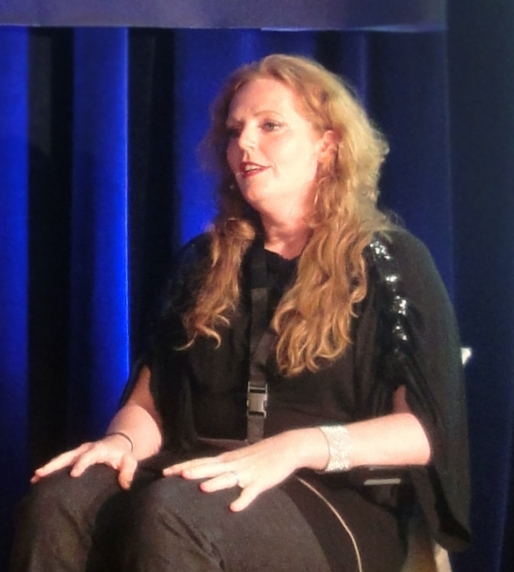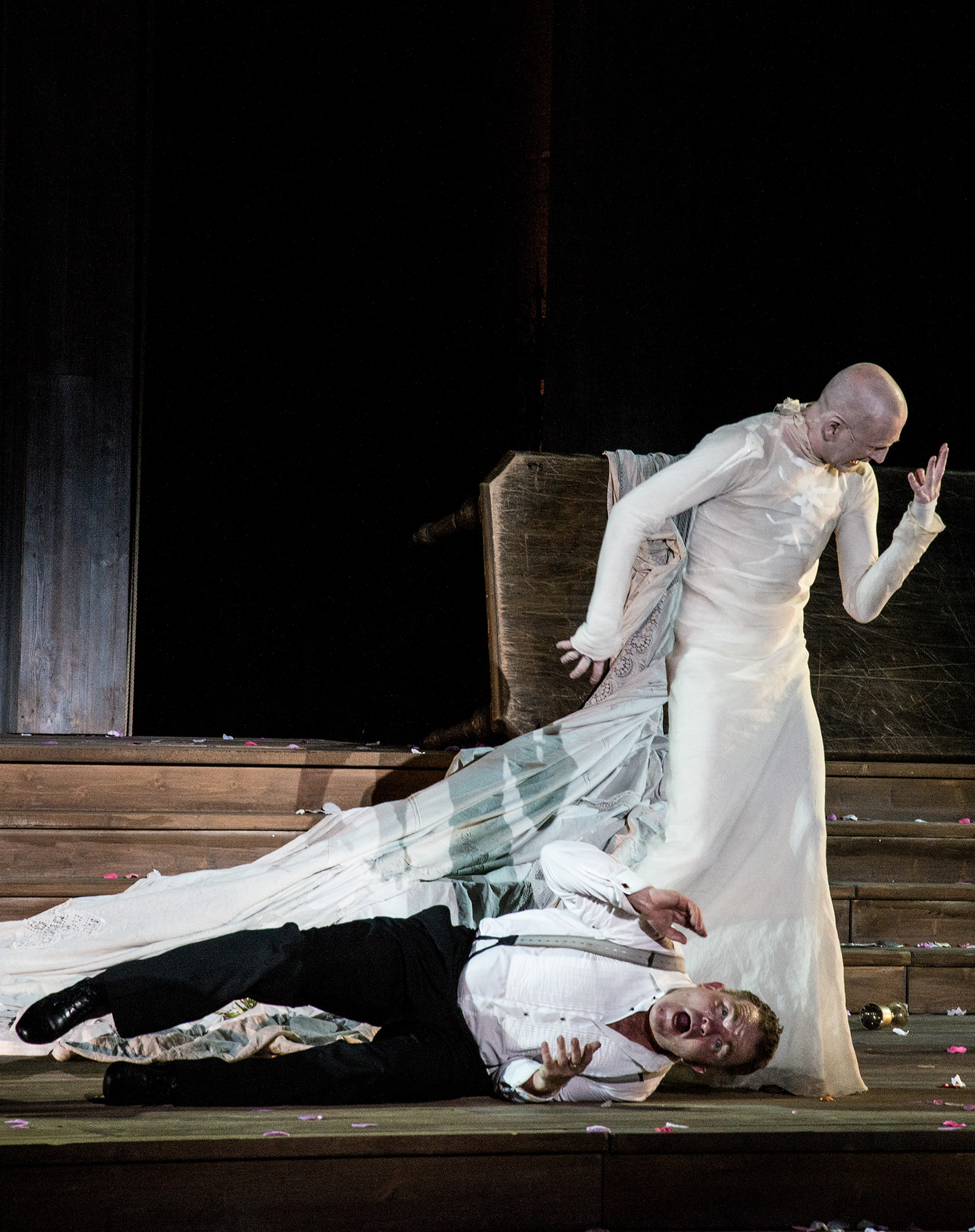|
Eva-Maria Westbroek
Eva-Maria Westbroek (born 26 April 1970) is a Dutch soprano opera singer. Training Westbroek studied at the Royal Conservatory of The Hague from 1988 to 1995. Her vocal teachers included Iris Adami Corradetti and the American tenor James McCray. Career 1990s Westbroek made her operatic debut at the Aldeburgh Festival in 1994 as Mère Marie in Poulenc's ''Dialogues des Carmélites''. She was a prize winner at an international competition in Rome, which allowed her to sing the role of Tosca at age 25. She also was a laureate at the Angelica Catalani Concours and the Santa Maria Ligure Concours. A subsequent slow spell in her career followed, during which time her mother died. Westbroek also worked as a singing waitress during that period. 2000s In 2001, Westbroek secured a 5-year contract as a company member of the Staatsoper Stuttgart. Her roles in Stuttgart included Carlotta ( Schreker, ''Die Gezeichneten''), Tosca, Emilia Marty ( Janáček, ''Věc Makropulos)'', Desdemona ... [...More Info...] [...Related Items...] OR: [Wikipedia] [Google] [Baidu] |
Jenůfa
''Její pastorkyňa'' (''Her Stepdaughter''; commonly known as ''Jenůfa'' ) is an opera in three acts by Leoš Janáček to a Czech libretto by the composer, based on the play ''Její pastorkyňa'' by Gabriela Preissová. It was first performed at the National Theatre, Brno on 21 January 1904. Composed between 1896 and 1902, it is among the first operas written in prose. The first of Janáček's operas in which his distinctive voice can clearly be heard, it is a grim story of infanticide and redemption. Like the playwright's original work, it is known for its unsentimental realism. While today it is heard in the composer's original version, ''Jenůfas early popularity was due to a revised version by Karel Kovařovic, altering what was considered its eccentric style and orchestration. Thus altered, it was well-received, first in Prague, and particularly after its Vienna première also worldwide. More than 70 years passed before audiences again heard it in Janáček's original ve ... [...More Info...] [...Related Items...] OR: [Wikipedia] [Google] [Baidu] |
Covent Garden
Covent Garden is a district in London, on the eastern fringes of the West End, between St Martin's Lane and Drury Lane. It is associated with the former fruit-and-vegetable market in the central square, now a popular shopping and tourist site, and with the Royal Opera House, itself known as "Covent Garden". The district is divided by the main thoroughfare of Long Acre, north of which is given over to independent shops centred on Neal's Yard and Seven Dials, while the south contains the central square with its street performers and most of the historical buildings, theatres and entertainment facilities, including the London Transport Museum and the Theatre Royal, Drury Lane. The area was fields until briefly settled in the 7th century when it became the heart of the Anglo-Saxon trading town of Lundenwic, then abandoned at the end of the 9th century after which it returned to fields. By 1200 part of it had been walled off by the Abbot of Westminster Abbey for use as arable l ... [...More Info...] [...Related Items...] OR: [Wikipedia] [Google] [Baidu] |
Royal Opera House
The Royal Opera House (ROH) is an opera house and major performing arts venue in Covent Garden, central London. The large building is often referred to as simply Covent Garden, after a previous use of the site. It is the home of The Royal Opera, The Royal Ballet, and the Orchestra of the Royal Opera House. The first theatre on the site, the Theatre Royal (1732), served primarily as a playhouse for the first hundred years of its history. In 1734, the first ballet was presented. A year later, the first season of operas, by George Frideric Handel, began. Many of his operas and oratorios were specifically written for Covent Garden and had their premieres there. The current building is the third theatre on the site, following disastrous fires in 1808 and 1856 to previous buildings. The façade, foyer, and auditorium date from 1858, but almost every other element of the present complex dates from an extensive reconstruction in the 1990s. The main auditorium seats 2,256 people, mak ... [...More Info...] [...Related Items...] OR: [Wikipedia] [Google] [Baidu] |
Lady Macbeth Of The Mtsensk District (opera)
''Lady Macbeth of Mtsensk'' (russian: Леди Макбет Мценского уезда, translit=Ledi Makbet Mtsenskogo uyezda, link=no, translation=Lady Macbeth of the Mtsensk District) is an opera in four acts and nine scenes by Dmitri Shostakovich, his Opus 29. The libretto, jointly written by Alexander Preys and the composer, is based on the novella ''Lady Macbeth of the Mtsensk District'' by Nikolai Leskov. Dedicated by Shostakovich to his first wife, physicist Nina Varzar, the roughly 160-minute opera was first performed on 22 January 1934 at the Leningrad Maly Operny, and two days later in Moscow. It incorporates elements of expressionism and verismo, telling the story of a lonely woman in 19th-century Russia who falls in love with one of her husband's workers and is driven to murder. Performance history Despite early success on popular and official levels, ''Lady Macbeth'' became the vehicle for a general denunciation of Shostakovich's music by the Communist ... [...More Info...] [...Related Items...] OR: [Wikipedia] [Google] [Baidu] |
Shostakovich
Dmitri Dmitriyevich Shostakovich, , group=n (9 August 1975) was a Soviet-era Russian composer and pianist who became internationally known after the premiere of his First Symphony in 1926 and was regarded throughout his life as a major composer. Shostakovich achieved early fame in the Soviet Union, but had a complex relationship with its government. His 1934 opera '' Lady Macbeth of Mtsensk'' was initially a success, but eventually was condemned by the Soviet government, putting his career at risk. In 1948 his work was denounced under the Zhdanov Doctrine, with professional consequences lasting several years. Even after his censure was rescinded in 1956, performances of his music were occasionally subject to state interventions, as with his Thirteenth Symphony (1962). Shostakovich was a member of the Supreme Soviet of the RSFSR (1947) and the Supreme Soviet of the Soviet Union (from 1962 until his death), as well as chairman of the RSFSR Union of Composers (1960–1968 ... [...More Info...] [...Related Items...] OR: [Wikipedia] [Google] [Baidu] |
De Nederlandse Opera
The Dutch National Opera (DNO; formerly De Nederlandse Opera, now De Nationale Opera in Dutch) is a Dutch opera company based in Amsterdam, Netherlands. Its present home base is the Dutch National Opera & Ballet housed in the Stopera building, a modern building designed by Cees Dam and Wilhelm Holzbauer which opened in 1986. History The DNO was established shortly after the end of World War II as a repertory company with a permanent ensemble. In the postwar period, it toured extensively in the Netherlands from its home base in the Stadsschouwburg, a ''fin de siècle'' theatre on the Leidseplein in Amsterdam. In 1964, it was renamed ''De Nederlandse Operastichting''. (''The Dutch Opera Foundation''), and the company adopted a ''stagione'' orientation, inviting different soloists and artistic teams for each new production. In 1986, the company moved to the new Stopera building, which it shares with the Dutch National Ballet, and thereafter became known as De Nederlandse Opera (DNO) ... [...More Info...] [...Related Items...] OR: [Wikipedia] [Google] [Baidu] |
Opéra Bastille
The Opéra Bastille (, "Bastille Opera House") is a modern opera house in the 12th arrondissement of Paris, France. Inaugurated in 1989 as part of President François Mitterrand's '' Grands Travaux'', it became the main facility of the Paris National Opera, France's principal opera company, alongside the older Palais Garnier; most opera performances are shown at the Bastille along with some ballet performances and symphony concerts, while Palais Garnier presents a mix of opera and ballet performances. Designed by Uruguayan architect Carlos Ott, it is situated facing Place de la Bastille. It may seat 2,723 people in total, with a main theatre, concert hall and studio theatre. History Background and construction The idea of a new "popular and modern" opera house in Paris first arose in the 1880s, only years after the opening of the Palais Garnier. It would remain virtual for a century and reemerge periodically due to the recurrent "crisis at the Opera" and to the limita ... [...More Info...] [...Related Items...] OR: [Wikipedia] [Google] [Baidu] |
Die Bakchantinnen
''Die Bakchantinnen'' is a 1931 German-language opera by Egon Wellesz to libretto by the composer after Euripides' play ''The Bacchae''.Julia Meszaros, Johannes Zachhuber ''Sacrifice and Modern Thought'' 0199659281 2013 - Page 242 "More ambiguous is Egon Wellesz's opera Die Bakchantinnen (1931), for which he wrote the libretto. Wellesz outdoes Euripides by directly representing the death of Pentheus, and the massed, torch-bearing Maenads who advance on him may represent the gathering forces of National Socialism." Recording * Thomas Mohr, Michael Burt, Harald Stamm, Roberta Alexander & Claudia Barainsky. Berlin Deutsche Symphony Orchestra, Gerd Albrecht Gerd Albrecht (19 July 1935 – 2 February 2014) was a German conductor. Biography Albrecht was born in Essen, the son of the musicologist Hans Albrecht (1902–1961). He studied music in Kiel and in Hamburg, where his teachers included Wilhel ... Orfeo - Musica Rediviva References 1931 operas German-language operas Oper ... [...More Info...] [...Related Items...] OR: [Wikipedia] [Google] [Baidu] |
Egon Wellesz
Egon Joseph Wellesz CBE (21 October 1885 – 9 November 1974) was an Austrian, later British composer, teacher and musicologist, notable particularly in the field of Byzantine music. Early life and education in Vienna Egon Joseph Wellesz was born on October 21, 1885 in the Schottengasse district of Vienna to Samú Wellesz and Ilona Wellesz (née Lovenyi). Although his parent met and married in Vienna, they both originated from Hungary and came from Jewish families in that nation. His parents, while ethnically Hungarian Jews, were both practicing Christians in Vienna and Wellesz received a Protestant upbringing. He later converted to Catholicism. As a boy he attended the Franz Josephs Gymnasium on Hegel Street where he received a classical education in Greek and Latin. Wellesz's father worked in the textile business and his parents initially intended Wellesz to join him in his work, or pursue a career as a civil servant. In order to achieve that aim, his parents were intent up ... [...More Info...] [...Related Items...] OR: [Wikipedia] [Google] [Baidu] |
Salzburger Festspiele
The Salzburg Festival (german: Salzburger Festspiele) is a prominent festival of music and drama established in 1920. It is held each summer (for five weeks starting in late July) in the Austrian town of Salzburg, the birthplace of Wolfgang Amadeus Mozart. One highlight is the annual performance of the play '' Jedermann'' (''Everyman'') by Hugo von Hofmannsthal. Since 1967, an annual Salzburg Easter Festival has also been held, organized by a separate organization. History Music festivals had been held in Salzburg at irregular intervals since 1877 held by the International Mozarteum Foundation but were discontinued in 1910. Although a festival was planned for 1914, it was cancelled at the outbreak of World War I. In 1917, Friedrich Gehmacher and Heinrich Damisch formed an organization known as the ''Salzburger Festspielhaus-Gemeinde'' to establish an annual festival of drama and music, emphasizing especially the works of Mozart. At the close of the war in 1918, the festival's re ... [...More Info...] [...Related Items...] OR: [Wikipedia] [Google] [Baidu] |






